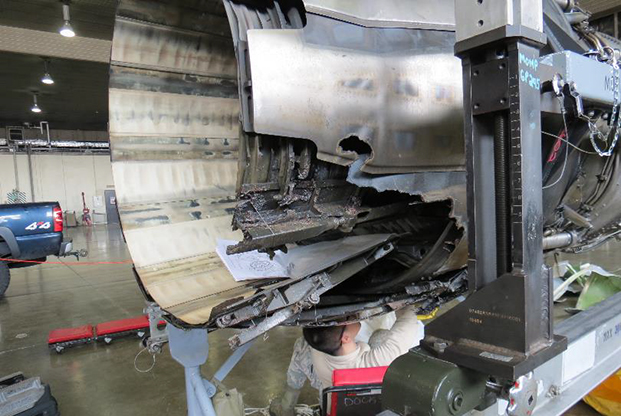
This photo from the Air Force Investigation Board report shows exhaust nozzle burn damage to the F-16. USAF photo.
An F-16 pilot from Misawa AB, Japan, was forced to jettison fuel tanks and immediately return to base due to an engine issue originally stemming from incorrect practices and the “general disarray” of the base’s maintenance shop six years earlier, an Air Force investigation found.
On the morning of Feb. 20, 2018, an F-16CM, tail number 92-3883, from the 13th Fighter Squadron, took off from Misawa for a routine training sortie when the aircraft’s engine caught fire. The pilot immediately turned back toward the base, jettisoned the external fuel tanks over Lake Ogawara, and was able to safely land.
Investigators said his actions were “focused, precise, and appropriate.” The same couldn’t be said for the maintenance shop.
The primary cause of the incident was an obsolete part—a turbine frame forward fairing—that was installed on a brack that was not compatible six years early during a service life extension maintenance overhaul in 2012. The part failed during the flight and caused the engine fire. Between the engine damage and the loss of the external tanks, the mishap was estimated to cost just under $1 million, according to an Air Force Accident Investigation Board report released Monday.
Routine inspections on the aircraft would not have caught the issue with the fairing, according to the report.
Through interviews with maintainers, the investigation board found that “poor enforcement of standard maintenance protocols” inside the Misawa maintenance shop led to the improper completion of paperwork to ensure parts accountability, a severe disorganization at the shop, improper handling of parts, and a failure to follow proper procedures for cannibalizing parts from other aircraft. In 2015, when a new senior noncommissioned officer arrived, he found the shop in disarray and without organization.
“It was mix and match, with no standardization of where things went,” the report states. “The shop had their own ‘method of the madness.’ ”
Because things were in such disarray, the shop “received a half a million dollars” to revamp and get back to standards.
“Given the strict protocols governing how parts are ordered and installed, a preponderance of the evidence shows the poor enforcement of standard maintenance protocols in 2012 created an environment within the Propulsion Flight that was a substantially contributing factor to the order and installation of the obsolete forward fairing that caused the fire,” the report states.
During this time period, Misawa experienced another mishap. In July 2012, an F-16C from the 14th Fighter Squadron at Misawa crashed into the Pacific Ocean about 750 miles away form the base. The pilot was able to eject and was safely recovered without injury.
The investigation into this crash found an uncommanded closure of the aircraft’s main fuel shutoff valve caused the crash. However, the aircraft was wrecked and much of it sank to the bottom of the ocean so a specific cause of the issue was not determined. That investigation found that the maintenance squadron did not have a corrosion preventative compound, which was prescribed by a task order for the aircraft and could have helped prevent an uncommanded closure of the valve, in stock for at least two years. Additionally, a Lockheed Martin technician who worked on the aircraft was found to not be proficient.